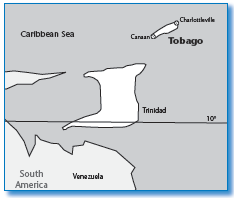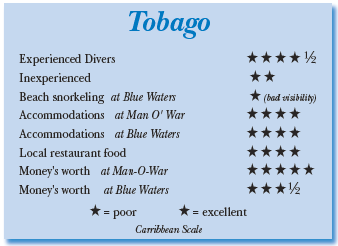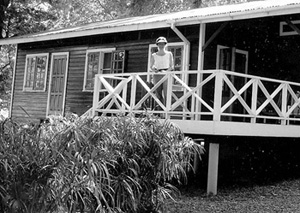Tobago, West IndiesContents of this Issue: Aqua Lung’s “Mistral” Regulator Scubapro MK20 Cracking Problem Reported Editorial Office: Ben Davison Publisher and Editor Undercurrent 3020 Bridgeway, Suite 102 Sausalito, CA 94965 not your everyday Caribbean from the June, 2005 issue of Undercurrent
Dear Fellow Diver, During every Caribbean dive trip I make there’s a moment when I switch from nervous planning to relaxing. On this trip it came 20 minutes from the Tobago airport, when our driver Churchill (yes, many residents carry the legacy of the British Empire) stopped at a roadside vendor to buy us “doubles.” He handed me the Indo-Trinidadian chick pea sandwich with a big smile. The pleasure in sharing the joys of their island would be repeated again and again by Tobagons I met during my week-long stay in early March Two hours down the very winding Windward Highway, actually a two-lane road, the four of us and a mountain of gear arrived at our two-bedroom cottage on a remarkable beach in tiny Charlotteville at the northeast end of the island. Soon I had 12 Guinnesses in the fridge and a blue crowned motmot out the window. I was at the right place. Later in the day, a driver from Aqua Marine Dive took us on the 10-minute, almost vertical drive over the hill to Speyside, on the Atlantic side, where Tobago’s best diving is easily accessed. Independently owned, Aqua Marine is on the property of Blue Waters Inn, where most divers stay. Rooms in the two story building are similar to those in the Holiday Inn, clean and ordinary, but sit on a beautiful beach. They also have duplexes and bungalows. Aqua Marine ran an efficient operation, with the
dives on schedule and the air-fills usually 3000 psi. The
crew are a nice bunch. Sometimes between dives I would
hang in front of the shop, which featured a tame blue and
yellow macaw who is puppy-dog loyal to the owner, Alice
Darwent, who would be sitting there, servicing equipment.
Their small covered boats have little storage area and no place to keep so much as a T-shirt dry.
Most sites are no more than ten minutes from the dock. The first couple of dives at Cathedral and Spiny Colony disappointed: a sloping wall to the 70-foot bottom with a nice current and the usual reef suspects. At Spiny Colony I spent quality time with a foraging octopus. The visibility was only 30-40 feet. While water from Venezuela’s muddy Orinoco river reaches here, winter mud slides silted the closer sites near the small islands of Little Tobago and Goat Island. We’d been on the lee side of those islands, where the dive operator takes new arrivals. (Snorkeling in the murky cove wasn’t much.) A visiting dive instructor told me that unless we pushed, Aqua Marine would stick to the close and easy sites and he suggested a few sites to request firmly. A great tip. The diving improved. At Book Ends, I back rolled through fizzy water with a deflated BCD to descend quickly and avoid the rock pinnacles 20 feet from the boat. I shot through a rocky channel and over a small bowl. Along the wall I spotted three turtles: two hawksbills and later a three-footer that was probably a green. Big tarpon were above us as we drifted the wall at 60 feet. Barrel sponges were gnarly and convoluted from the monster current. A large barracuda darkened at a cleaning station, wiggling off as I passed by. In fact, barracudas were the only big food fish that I saw regularly. Snapper, grouper, jacks and even large parrotfish were uncommon. Aqua Marine calls “Special Site” an “advanced dive,” seemingly because of depth, so we requested it. (Same with Book Ends and a couple others they won’t do if newbies are on the boat). We circled a huge rock pinnacle, starting at 100 feet and ending at 60, with deep blue on my right, huge tarpon over head, and big schools around me. A 3-ft foot cubera snapper passed by, a wily character that has dodged the fishing pressure. More hawksbills appeared. Cherubfish flitted in the corals, at shallower depths than in most of the Caribbean. My air was at 700 psi when a friendly German diver zoomed past from the back of the pack, grabbed the divemaster’s spare second stage and kicked for the surface at a rate not recommended by any known agency. The divemaster was less than pleased about being dragged to the surface, but simply suggested that he “chill” for the next dive. A rather light sentence considering the offense. I was feeling much better about Tobago diving after Special Site, but Back Garden sealed the deal. We entered the water on the windward side of Goat Island, with one guide towing a large float. As we flowed over coral heads and sand flats, the current gradually increased and we were jetting. I flew over a short wall, but then the current stopped so suddenly I practically tumbled over. I was surrounded by thousands of fish: schools of tomtates, durgons, schoolmasters, a large dog snapper with a remora, and a giant school of Creolefish engulfed me. This is Tobago diving at its best. Diving here has a different feel from elsewhere in the Caribbean. Tobago
is geologically part of South America. Most divers were Germans and Brits, some so accustomed to cold water they dived in this 82-degree water without wet suits. One English woman who had 1980’s equipment carried a knife on every dive because she had been trapped and silted out in a fishing net in the North Sea a few years ago. There are some decent aquarium dives, too. At Japanese Garden I watched the spawning rushes of bluehead wrasse near the top of the wall, and spent the safety stop in the shallows finding lettuce sea slugs. At Coral Gardens a three-foot sharksucker seemed to be checking out my buddy as potential real estate. She was wary but enjoyed a close inspection of the bizarre sucker-head. I also noted differences in the fish and invertebrate life from most of the Caribbean. Schools of bogas and Creole wrasse are often replaced here by Creolefish, which, despite the similar name, are actually plankton-eating groupers. The dominant damsels are bicolors, which form large colonies on the sloping walls. Many trumpetfish have bright purple or yellow snouts. I’m something of a tunicate nut (I’m the one with both a light and a big magnifying glass hanging from my wrist); the usually uncommon white condominium tunicates make every wall look like it’s covered with golf balls. The dive guides, all from Tobago or Trinidad, were competent and all-business when on the boat. They didn’t offer much creature-scouting help, nor help with gear, though a few folks could have used a hand. They announced a short time-limit for each dive, but would overstay it if no diver signaled low air. With four in my group, I figured we would have enough leverage to bargain some variation in a well-worn routine, but they would have none of it. They wouldn’t do three dives a day except with essentially no interval between the morning dives, so we settled for two and adopted a more laid-back schedule. Between the dives we’d take a half mile walk to Jenna’s Tree House restaurant for lunch, or grab a sandwich at the Blue Waters Inn. Sometimes, we’d bring food from our cottage and have a picnic.
While the Blue Waters Inn is a pleasant place, staying in Charlotteville was a better choice. We paid much less than half the rate at Blue Waters. While nothing fancy — they remind me of lake-side cottages in Northern Michigan — the ten Man-O-War cottages run $65-$85 per night for a one-bedroom, $85-$110 for two bedrooms. They have no a/c, but with lots of screened windows I didn’t miss it. They are cleaned and supplied with plenty of fresh towels daily. Cottage #10 has two quiet private bedrooms each with twin beds, a kitchen, living room and bath, and a deck 50 feet from the gentle lapping waves of the Caribbean. The kitchen was well equipped and in the morning I’d make a cup of instant coffee (the only kind available in town) sit on the deck and watch the birds (bring your binos) and admire the huge trees adorned with bromeliads and other epiphytes. We were regularly graced by night-crowned herons, flitting black and yellow bananaquits, raucous chachalacas, and the iridescent motmot, with its long, racket-shaped tail. The place is owned by Pat Turpin, the president of the T & T Field Naturalist Club, so it’s no surprise that the grounds consist of bird habitat among native plants. (However, one bird was not appreciated: the world’s loudest rooster, who welcomed the morn way too early. Funny how after two days I slept through it.) Charlotteville, a 3-minute walk from the cottage, is irresistibly friendly, Tobago’s fishing capital and relaxation zone. I ate at Sharon and Phebe’s most evenings and loved the kingfish (the local name for wahoo). Gail’s is another good choice. Her Caliloo soup featured the greens of dasheen (taro), a staple in Tobago and Trinidad. Dinners are in the $10 range, beer is $1.50 in the bar and a lot less by the six pack. The local beers, Carib and Stag, are OK but I adopted Guinness. An evening walk through town became a daily routine: visit tiny local bars, pick up breakfast makings of fresh bread and cheese at one stand and fruit from another, and have a look at what fish the locals are cleaning. A walk down the beach from one side of Man-O-War Cottages gets you to the Banana Boat breakfast joint and bar. On the other side is a beach bar where one night we enjoyed a local pan (steel drum) group. You could almost get high just breathing there. It’s pretty much impossible to get to Tobago from the U.S. without laying over in Port of Spain, Trinidad. Take advantage of it. We rented a car at the airport and drove two hours (on the left side) to the north coast. The Mt. Plaisir (yeah, that’s mount pleasure) eco-hotel is an inexpensive and yet almost decadent experience. I did some incredible walking and birding in the rain forest, body surfed, and enjoyed Trinidadian cooking a cut above Tobago. Best of all, at 11 p.m., a local volunteer conservationist knocked on the door and led us to a prehistoric monster. A 7-foot (“this is a small one”) leatherback, the largest turtle species that has ever lived, was digging a one meter deep hole, dropping in some 50 eggs, then carefully refilling and tamping the nest before she laboriously made her way back to the sea. I stood with a small group of people in silence for 90 minutes, until she disappeared into the surf. We let out a spontaneous cheer. The volunteer told me if you dive off that coast in the midsummer peak laying season, you can see dozens of these endangered giants, which average 8-9 feet. (Another good choice for an overnight is the Asa Wright Nature Center.) For me, the leatherback was just the right closing. Tobago diving had been quite good by Caribbean standards – maybe not the best, but different enough to make it well worth the trip. And the island’s other pleasures are delicious. If you find that six cruise ships a day in Cozumel is about six too many, try Charlotteville and Speyside – where there’s not even an ATM yet. -- M.A.
|

I want to get all the stories! Tell me how I can become an Undercurrent Online Member and get online access to all the articles of Undercurrent as well as thousands of first hand reports on dive operations world-wide
| Home | Online Members Area | My Account |
Login
|
Join
|
| Travel Index |
Dive Resort & Liveaboard Reviews
|
Featured Reports
|
Recent
Issues
|
Back Issues
|
|
Dive Gear
Index
|
Health/Safety Index
|
Environment & Misc.
Index
|
Seasonal Planner
|
Blogs
|
Free Articles
|
Book Picks
|
News
|
|
Special Offers
|
RSS
|
FAQ
|
About Us
|
Contact Us
|
Links
|
3020 Bridgeway, Ste 102, Sausalito, Ca 94965
All rights reserved.

 They carried a DAN O2 kit. With eight divers
aboard, we were airline-coach crowded, but at
times we had as few as four. After I rinsed my
gear, I stored it securely in the shop for the
night.
They carried a DAN O2 kit. With eight divers
aboard, we were airline-coach crowded, but at
times we had as few as four. After I rinsed my
gear, I stored it securely in the shop for the
night. In fact, that 1,000-foot hill above
Speyside is the tip of the tail of the Andes range. Underwater, the scene is big and rocky, and on the best
dives I felt like I was combining
scuba and rock-climbing.
Currents are tough and
one needs to be attentive. At
Flying Manta, the briefing was
simple: when you get to the narrows,
stay to the right or you
will enter the “washing machine
. . . and the last person who
went there never came out.” My
buddy and I were following a
turtle when I noticed that the
group was not in sight. I could
see the foam above. A hard swim
against the grain got us back
with the “unwashed.” (In 1998,
Undercurrent reported how one of
their divers, American Vivienne Slear, got lost and drifted twenty-seven hours
before she could climb ashore several miles down the coast.)
In fact, that 1,000-foot hill above
Speyside is the tip of the tail of the Andes range. Underwater, the scene is big and rocky, and on the best
dives I felt like I was combining
scuba and rock-climbing.
Currents are tough and
one needs to be attentive. At
Flying Manta, the briefing was
simple: when you get to the narrows,
stay to the right or you
will enter the “washing machine
. . . and the last person who
went there never came out.” My
buddy and I were following a
turtle when I noticed that the
group was not in sight. I could
see the foam above. A hard swim
against the grain got us back
with the “unwashed.” (In 1998,
Undercurrent reported how one of
their divers, American Vivienne Slear, got lost and drifted twenty-seven hours
before she could climb ashore several miles down the coast.)
 Divers Compass: Aqua Marine Dive (
Divers Compass: Aqua Marine Dive (